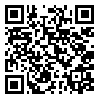1. Ghalae-Bandi F. Psychiatry for medical students and general practitioners. Tehran: publishing institute of Culture Makers; 2000. [Persian]
2. Ganji M. Psychopathy based on DSM- V. Tehran: Savalan publishing institute; 2014. [Persian]
3. Barkley R. ADHD and the nature of self-control: The Guilford Press; 1997.
4. Khoushabi K, Pouretemad H, Mohammadi M, Houman A, Biglarian A, Tofigh N. Prevalence of ADHD and associated disorders in primary school students in Tehran. [Thesis]. Tehran: University of Social Welfare and Rehabilitation; 2002. [Persian]
5. Mangeot SD, Miller LJ, McIntosh DN, McGrath-Clarke J, Simon J, Hagerman RJ, et al. Sensory modulation dysfunction in children with attention-deficit-hyperactivity disorder. Developmental medicine and child neurology. 2001;43(6):399-406. [
DOI:10.1017/S0012162201000743]
6. Yousefi Sh, Soltani Far A, Teimouri S. Comparison of parenting stress in mothers of children with attention deficit hyperactivity disorder with mothers of normal children. Journal of Mental Health. 2009; 2 (42): 115-122. [Persian]
7. Anastasi A. Psychological testing. New York: Macmillan; 1988.
8. Angold A, Costello EJ, Erkanli A. Comorbidity. J Child Psychol Psychiatry. 1999 Jan;40(1):57-87. [
DOI:10.1017/S0021963098003448]
9. Ayres AJ. Tactile functions. Their relation to hyperactive and perceptual motor behavior. The American journal of occupational therapy: official publication of the American Occupational Therapy Association. 1963;18:6-11.
10. Barkley RA. Attention-deficit hyperactivity disorder: A handbook for diagnosis and treatment. Guilford Publications; 2014.
11. Dunn W, Bennett D. Patterns of sensory processing in children with attention deficit hyperactivity disorder. OTJR: Occupation, Participation and Health. 2002;22(1):4-15. [
DOI:10.1177/153944920202200102]
12. Yochman A, Parush S, Ornoy A. Responses of preschool children with and without ADHD to sensory events in daily life. American Journal of Occupational Therapy. 2004;58(3):294-302. [
DOI:10.5014/ajot.58.3.294]
13. Dunn W. Supporting children to participate successfully in everyday life by using sensory processing knowledge. Infants & Young Children. 2007;20(2):84-101. [
DOI:10.1097/01.IYC.0000264477.05076.5d]
14. Engel-Yeger B, Ziv-On D. The relationship between sensory processing difficulties and leisure activity preference of children with different types of ADHD. Research in developmental disabilities. 2011;32(3):1154-1162. [
DOI:10.1016/j.ridd.2011.01.008]
15. Molagholamreza Tabasi F, Ali Aadi F, Alizade Zaeri M, Qorbani M, Rostami R. The relationship between sensory processing and behavioral problems in children with attention deficit hyperactivity disorder 7 to 10 years and normal children at the same age. ]MS Thesis of Occupational Therapy.[ Iran University of Medical Sciences; School of Rehabilitation Sciences, 2014. [Persian]
16. Behar LB. The preschool behavior questionnaire. Journal of Abnormal Child Psychology. 1977;5(3):265-275. [
DOI:10.1007/BF00913697]
17. Behar L, Stringfield S. Manual for the Preschool Behavior Questionnaire. ERIC. 1974. [
DOI:10.1037/t05316-000]
18. Blondis TA. Motor disorders and attention-deficit/hyperactivity disorder. Pediatric Clinics of North America. 1999;46(5):899-913. [
DOI:10.1016/S0031-3955(05)70162-0]
19. Campbell SB. Behavior problems in preschool children: A review of recent research. Journal of child Psychology and Psychiatry. 1995;36(1):113-149. [
DOI:10.1111/j.1469-7610.1995.tb01657.x]
20. Campbell SB, Breaux AM, Ewing LJ, Szumowski EK. Correlates and predictors of hyperactivity and aggression: A longitudinal study of parent-referred problem preschoolers. Journal of abnormal child psychology. 1986;14(2):217-234. [
DOI:10.1007/BF00915442]
21. Tseng M-H, Fu C-P, Cermak SA, Lu L, Shieh J-Y. Emotional and behavioral problems in preschool children with autism: Relationship with sensory processing dysfunction. Research in Autism Spectrum Disorders. 2011;5(4):1441-1450. [
DOI:10.1016/j.rasd.2011.02.004]
22. Dunn W. The Sensory Profile manual. The Psychological Corporation, San Antonio; 1999. [
DOI:10.1037/t15155-000]
23. McIntosh DN, Miller LJ, Shyu V, Dunn W. Development and validation of the short sensory profile. Sensory profile manual. 1999;59-73.
24. MirzaKhani N, Zeinali R. Iranian version of Short Sensory Profile in children 5 to 12 years. Beheshti University of Medical Sciences Journal. [Persian]
25. Achenbach T, Rescorla LA. Manual for the ASEBA School-Age Forms & Profiles. Research Center for Children, Youth, & Families, Burlington. 2001.
26. Ahadi B. Comparison of behavior problems and academic achievement in children with and without motor problems. Journal of Rehabilitation. 2009;10 (37): 32-36.[Persian]
27. Stellar J. The neurobiology of motivation and reward. Springer Science & Business Media; 2012.
28. Dunn W. The impact of sensory processing abilities on the daily lives of young children and their families: A conceptual model. Infants and young children. 1997;9:23-35. [
DOI:10.1097/00001163-199704000-00005]






